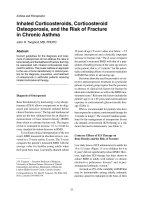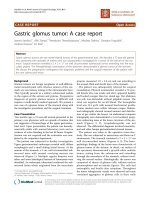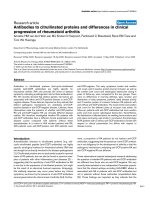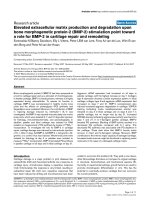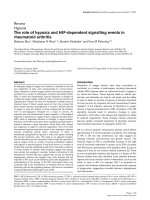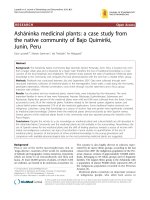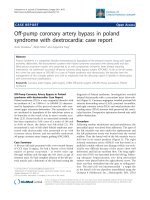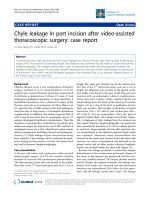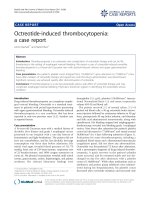Báo cáo y học: " Elevated maternal lipoprotein (a) and neonatal renal vein thrombosis: a case report" pps
Bạn đang xem bản rút gọn của tài liệu. Xem và tải ngay bản đầy đủ của tài liệu tại đây (690.03 KB, 4 trang )
BioMed Central
Page 1 of 4
(page number not for citation purposes)
Journal of Medical Case Reports
Open Access
Case report
Elevated maternal lipoprotein (a) and neonatal renal vein
thrombosis: a case report
Vivek Subbiah
1
and Prabhu Parimi*
2
Address:
1
Department of Internal Medicine/Pediatrics, Case Western Reserve University School of Medicine, MetroHealth Medical Center,
Cleveland, OH 44109, USA and
2
Division of Neonatology, Department of Pediatrics, University of Kansas, KU Medical Center, Kansas City, KS
66160, USA
Email: Vivek Subbiah - ; Prabhu Parimi* -
* Corresponding author
Abstract
Introduction: Renal vein thrombosis, although rare in adults, is well recognized in neonates and
is one of the most common manifestations of neonatal thromboembolic events. The etiology of
renal vein thrombosis remains unidentified in the majority of cases. We report a case of renal vein
thrombosis in a neonate associated with elevated maternal lipoprotein (a).
Case presentation: A full-term female infant, appropriate for gestational age, was born via
spontaneous vaginal delivery to an 18-year-old primigravida. The infant's birth weight was 3680 g
and the Apgar scores were eight and nine at 1 and 5 minutes respectively. Evaluation of the infant
in the newborn nursery revealed a palpable mass in the right lumbar area. Tests revealed hematuria
and a high serum creatinine level of 1.5 mg/dl. An abdominal ultrasound Doppler flow study
demonstrated an enlarged right kidney, right renal vein thrombosis, and progression of the
thrombosis to the inferior vena cava. There was no evidence of saggital sinus thrombosis. An
extensive work-up of parents for hypercoagulable conditions was remarkable for a higher plasma
lipoprotein (a) level of 73 mg/dl and an elevated fibrinogen level of 512 mg/dl in the mother. All
paternal levels were normal. The plasma lipoprotein (a) level in the neonate was also normal. The
neonate was treated with low molecular weight heparin (enoxaparin) at 1.5 mg/kg/day every 12
hours for 2 months, at which time a follow-up ultrasound Doppler flow study showed resolution
of the thrombosis in both the renal vein and the inferior vena cava.
Conclusion: There have been no studies to date that have explored the effect of abnormal
maternal risk factors on fetal hemostasis. A case-control study is required to investigate whether
elevated levels of maternal lipoprotein (a) may be a risk factor for neonatal thrombotic processes.
Although infants with this presentation are typically treated with anticoagulation, there is a lack of
evidence-based guidelines. Treatment modalities vary between study and treatment centers which
warrants the establishment of a national registry.
Introduction
Renal vein thrombosis (RVT), although rare in adults, is
well recognized in neonates and is one of the most com-
mon manifestations of neonatal thromboembolic events
[1]. The clinical signs of neonatal RVT (NRVT) include an
enlarged kidney, hematuria, proteinuria, renal failure,
Published: 10 April 2008
Journal of Medical Case Reports 2008, 2:106 doi:10.1186/1752-1947-2-106
Received: 22 April 2007
Accepted: 10 April 2008
This article is available from: />© 2008 Subbiah and Parimi; licensee BioMed Central Ltd.
This is an Open Access article distributed under the terms of the Creative Commons Attribution License ( />),
which permits unrestricted use, distribution, and reproduction in any medium, provided the original work is properly cited.
Journal of Medical Case Reports 2008, 2:106 />Page 2 of 4
(page number not for citation purposes)
hypertension and/or thrombocytopenia. Long-term con-
sequences of NRVT include hypoplastic kidney, tubular
defects, hypertension and renal insufficiency [2]. We
report a case of NRVT associated with elevated maternal
lipoprotein (a) [Lp (a)].
Case presentation
A full-term female infant, appropriate for gestational age,
was born via spontaneous vaginal delivery, weighing
3680 g, to an 18-year-old primigravid Hispanic mother
and a 21-year-old African American father. The neonate
adapted well to extra-uterine life as evidenced by Apgar
scores of eight and nine at 1 and 5 minutes, respectively.
The pregnancy had been uneventful, and the maternal
screens were all negative. There was no evidence of diabe-
tes or pre-eclampsia during pregnancy. The neonate was
transferred to the newborn nursery for routine newborn
care. Physical examination in the newborn nursery
revealed a palpable mass in the right lumbar area. Signifi-
cant laboratory findings in the neonate included hematu-
ria, and an elevated serum creatinine level of 1.5 mg/dl
prompting transfer to the neonatal intensive care unit. A
renal ultrasound evaluation showed an enlarged right kid-
ney (5.56 cm) with loss of corticomedullary distinction. A
renal Doppler flow study demonstrated an increased resis-
tive index of the right renal artery with suboptimal wave
forms of the right renal vein and a clot in the right renal
vein (Figure 1). A Doppler flow study of the left renal
artery and vein was normal. The neonate had normal
blood pressures throughout the hospital stay.
The neonate and her parents were evaluated for pro-
thrombotic risk factors. The mother's laboratory parame-
ters were remarkable for an elevated level of Lp (a) of 73
mg/dl (normal 0 to 40 mg/dl), and fibrinogen of 512 mg/
dl (156 to 400 mg/dl). The plasma Lp (a) concentration
was measured by the enzyme-linked immunosorbent
assay (ELISA) technique using mouse monoclonal anti-
apo (a) capture antibody and sheep polyclonal anti-apoB
detection antibody (COALIZA Lp (a), Chromogenix). The
other laboratory tests on the mother were normal: plasma
homocysteine 5.3 µmol/l; protein C activity greater than
125%; protein S activity greater than 125%; anticardioli-
pin antibody IgG 6.2 IgG phospholipid binding units;
anticardiolipin IgM 6.4 IgM phospholipid binding units;
beta 2 glycoprotein IgG less than 9 standard IgG antibeta
2 glycoprotein units; beta 2 glycoprotein IGM less than 9
standard IgM antibeta 2 glycoprotein units; lupus antico-
agulant negative; Factor VIII A assay 108%; antinuclear
antibody (ANA) screening negative; antithrombin III
94%; prothrombin time (PT), partial thromboplastin
time (PTT), international normalized ratio (INR) normal.
DNA analysis showed no point mutation (G20210A) in
the 3' untranslated region of the prothrombin gene, no
genetic polymorphism (Arg 506/Glu 506) for Factor V Lei-
den, and no gene mutation (C677T) for 5' 10 methylene-
tetrahydrofolate reductase (MTHFR). The paternal screens
were all normal.
The plasma Lp (a) level in the neonate was 11 mg/dl (0 to
40 mg/dl). This was measured when the maternal Lp (a)
results became available, that is, 4 days after the diagnosis
of RVT. The plasma homocysteine level was 4.6 µmol/l (4
to 13.7 µmol/l). A computed tomography (CT) scan of the
head of the neonate was negative for saggital sinus throm-
bosis. The neonate was started on low molecular weight
heparin (enoxaparin) at 1.5 mg/kg/day every 12 hours,
with antifactor Xa monitoring. The antifactor Xa activity
measured was 0.74 IU/ml (less than 0.10 IU/ml). The
serum creatinine level decreased to 0.5 mg/dl 9 days after
initiation of treatment, and urinalysis showed no evi-
dence of hematuria. Renal ultrasound Doppler flow stud-
ies were repeated at weekly intervals during the hospital
stay. One week after initiation of treatment, an ultrasound
demonstrated persistence of RVT and development of a
new thrombosis in the inferior vena cava. The neonate
was discharged home on enoxaparin and followed by a
hematologist, a nephrologist and a primary care physi-
cian. A follow-up ultrasound Doppler flow study at 2
months of age showed a normal flow pattern in the aorta,
inferior vena cava, right and left renal arteries and veins
indicating resolution of the thrombosis (Fig. 2). Enoxa-
parin was discontinued at 2 months of age. The baby con-
tinued to do well with no evidence of residual renal
dysfunction or hypertension at 18 months of age.
Discussion
The etiology of NRVT remains unidentified in the major-
ity of cases. The existence of underlying predisposing fac-
tors, such as asphyxia, sepsis, diabetic fetopathy or
Renal Doppler flow study demonstrating an increased resis-tive index of the right renal artery with suboptimal wave forms of the right renal veinFigure 1
Renal Doppler flow study demonstrating an increased resis-
tive index of the right renal artery with suboptimal wave
forms of the right renal vein.
Journal of Medical Case Reports 2008, 2:106 />Page 3 of 4
(page number not for citation purposes)
indwelling intravascular catheters, in combination with
inherited prothrombotic risk factors, play a major role in
the pathogenesis of NRVT [1-4], however their role is not
well defined. The association between maternal throm-
bophilia and thrombotic complications in the neonate is
unknown [5].
Lp (a) consists of phospholipids, cholesterol and apolipo-
protein B-100 (low-density lipoprotein), with apolipo-
protein (a) attached to the latter at a single point. Recent
studies have demonstrated the significance of prothrom-
botic risk factors, especially the elevation of Lp (a) in the
etiology of NRVT. It has been shown that Lp (a) competes
with plasminogen for the plasminogen receptor on
endothelial cells and initiates thrombosis. It has also been
demonstrated that Lp (a) inactivates the 'tissue factor (TF)
pathway inhibitor', which is a major endogenous regula-
tor of TF-mediated coagulation [6]. Elevated plasma con-
centration of Lp (a) has been consistently shown to be a
risk factor for the development of a variety of thrombotic
and atherosclerotic disorders in humans. Lp (a) has been
implicated in NRVT [1] as well as in cerebral venous
thrombosis [5]. Lp (a) greater than 30 mg/dl has been
shown to be a risk factor for the development of venous
thromboembolism in children [7].
There is a paucity of data exploring prothrombotic risk
factors in the development of NRVT in neonates. None of
the studies reported to date have explored the effect of
abnormal maternal risk factors on fetal hemostasis. The
mechanism by which an elevated maternal Lp (a) with a
normal level in the neonate contributes to the formation
of a thrombus was unclear in this case. There is no evi-
dence that Lp (a) crosses the placenta given the large size
of this molecule. A higher level of maternal Lp (a) could
be an independent risk factor in neonatal thromboem-
bolic events. A case-control study is required to investigate
whether elevated levels of maternal Lp (a) are a risk factor
for neonatal thrombotic processes. In addition to measur-
ing plasma levels of Lp (a) by standardized methods,
genetic polymorphisms of Lp (a) should also be explored
to identify secretor haplotypes.
Conclusion
The infant reported here is now 18-months old, has nor-
mal renal function and has no evidence of hypertension.
Although infants with this presentation are typically
treated with anticoagulation, there is a lack of evidence-
based guidelines. The treatment modalities vary between
study and treatment centers which warrants the establish-
ment of a national registry. Screening for prothrombotic
risk factors in NRVT remains controversial [2,3,8,9]. Mess-
inger et al. [3] have reported that all neonates with unilat-
eral NRVT treated with heparin and with or without
fibrinolytics had either small or atrophic kidneys between
2 and 6.5 years of age, but had normal renal function. This
study underscores the importance of long-term follow-up
of neonates with NRVT.
Abbreviations
ANA: Antinuclear antibody; CT: Computed tomography;
ELISA: Enzyme-linked immunosorbent assay; Lp (a):
Lipoprotein (a); INR: International normalized ratio;
MTHFR: 5' 10 methylene tetrahydrofolate reductase;
NRVT: Neonatal renal vein thrombosis; PT: Prothrombin
time, PTT: Partial thromboplastin time; RVT: Renal vein
thrombosis; TF: Tissue factor.
Competing interests
The authors declare that they have no competing interests.
Authors' contributions
VS was involved in the patient's evaluation and clinical
care, and in the conception of the report, literature review,
and manuscript preparation, editing and submission. PP
was involved in the patient's evaluation and clinical care,
and in the conception of the report, manuscript prepara-
tion and editing, and administrative support. All authors
have read and approved the final manuscript.
Consent
Written informed consent was obtained from the patient's
next-of-kin for publication of this case report and accom-
panying images. A copy of the written consent is available
for review by the Editor-in-Chief of this journal.
References
1. Kosch A, Kuwertz-Broking E, Heller C, Kurnik K, Schobess R,
Nowak-Gottl U: Renal venous thrombosis in neonates: pro-
thrombotic risk factors and long-term follow-up. Blood 2004,
104(5):1356-1360.
Follow-up renal Doppler ultrasound flow at 2 months of age showing the normal flow pattern of the inferior vena cavaFigure 2
Follow-up renal Doppler ultrasound flow at 2 months of age
showing the normal flow pattern of the inferior vena cava.
Publish with BioMed Central and every
scientist can read your work free of charge
"BioMed Central will be the most significant development for
disseminating the results of biomedical research in our lifetime."
Sir Paul Nurse, Cancer Research UK
Your research papers will be:
available free of charge to the entire biomedical community
peer reviewed and published immediately upon acceptance
cited in PubMed and archived on PubMed Central
yours — you keep the copyright
Submit your manuscript here:
/>BioMedcentral
Journal of Medical Case Reports 2008, 2:106 />Page 4 of 4
(page number not for citation purposes)
2. Marks SD, Massicotte MP, Steele BT, Matsell DG, Filler G, Shah PS,
Perlman M, Rosenblum ND, Shah VS: Neonatal renal venous
thrombosis: clinical outcomes and prevalence of prothrom-
botic disorders. J Pediatr 2005, 146(6):811-816.
3. Messinger Y, Sheaffer JW, Mrozek J, Smith CM, Sinaiko AR: Renal
outcome of neonatal renal venous thrombosis: review of 28
patients and effectiveness of fibrinolytics and heparin in 10
patients. Pediatrics 2006, 118(5):e1478-84.
4. Manco-Johnson MJ, Grabowski EF, Hellgreen M, Kemahli AS, Massi-
cotte MP, Muntean W, Peters M, Nowak-Gottl U: Laboratory test-
ing for thrombophilia in pediatric patients. On behalf of the
Subcommittee for Perinatal and Pediatric Thrombosis of
the Scientific and Standardization Committee of the Inter-
national Society of Thrombosis and Haemostasis (ISTH).
Thromb Haemost 2002, 88(1):155-156.
5. Heller C, Heinecke A, Junker R, Knofler R, Kosch A, Kurnik K,
Schobess R, von Eckardstein A, Strater R, Zieger B, Nowak-Gottl U:
Cerebral venous thrombosis in children: a multifactorial ori-
gin. Circulation 2003, 108(11):1362-1367.
6. Caplice NM, Panetta C, Peterson TE, Kleppe LS, Mueske CS, Kostner
GM, Broze GJ Jr., Simari RD: Lipoprotein (a) binds and inacti-
vates tissue factor pathway inhibitor: a novel link between
lipoproteins and thrombosis. Blood 2001, 98(10):2980-2987.
7. Nowak-Gottl U, Junker R, Hartmeier M, Koch HG, Munchow N, Ass-
mann G, von Eckardstein A: Increased lipoprotein(a) is an
important risk factor for venous thromboembolism in child-
hood. Circulation 1999, 100(7):743-748.
8. Weinschenk N, Pelidis M, Fiascone J: Combination thrombolytic
and anticoagulant therapy for bilateral renal vein thrombo-
sis in a premature infant. Am J Perinatol 2001, 18(5):293-297.
9. Albisetti M, Moeller A, Waldvogel K, Bernet-Buettiker V, Cannizzaro
V, Anagnostopoulos A, Balmer C, Schmugge M: Congenital pro-
thrombotic disorders in children with peripheral venous and
arterial thromboses. Acta Haematol 2007, 117(3):149-155.
